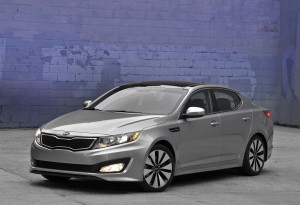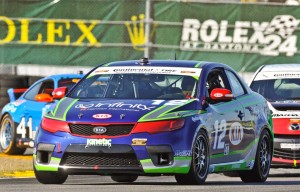Kia and motorsports? The idea might have seemed ludicrous just a few years ago considering the Korean carmaker’s econobox image. But as it prepared to launch of new products, such as the all-new Optima, the maker took a bet that that tearing up the track might be a way to grab the attention of consumers that barely knew Kia even existed.
Launched in 2009, the so-far successful effort seems to be having a significant impact on Kia’s brand perception, company officials claim.
When Kia decided to launch a major racing program, in 2009, it had never been part of any motorsports.
“This is a company that had never gone racing anywhere in the world,” noted Russell Smith of Kinetic Motorsports, the Atlanta-based racing team Kia sought out to help build a motorsports racing team.
Given the company’s history and lack of experience, he was puzzled and a bit skeptical when he was first approached by Kia’s representatives, Smith added. But after speaking to Kia officials, he decided the company was serious and also understood the risks since it could wind up competing with companies such as BMW and Honda with decades of experience in motorsports.

Kia's move into motor sports coincides with the most aggressive product campaign in the brand's history, including the launch of the 2011 Kia Optima.
“They only had one request. They didn’t want us standing at the side of the road,” added Smith, who recalls discovering that the Kia Forte Koup delivered to Kinetic’s 42,000-square-foot garage in Atlanta was a very good vehicle even without any formal “racing DNA.”
It had great chassis and terrific brakes, noted Nic Jonsson, Kinetic’s lead and resident racing expert.
Kinetic reworked the car to outfit it with a protective roll-cage and re-built the 2.4-liter gasoline engine to get more power, and in early 2010 went racing for the first time in the Grand Am Rolex Series. Despite taking on a number of more experienced teams, it managed to hold its own and even landed a podium finish.
The Kinetic team also began sending race data back to Kia engineering teams in Korea, Southern California and Ann Arbor, Mi. “They like the feedback,” said Jonsson, adding racing invariably helps improve the breed.
This year they’re back for more and enjoying some modest success.
Both of Kia’s cars finished the Grand Am Rolex Series race in Daytona, last month, and last weekend earned a sixth place finish in its class on the road course at Miami-Homestead.
The Kia team was elated with the finish because the Homestead course was the toughest on the circuit for their cars. They didn’t do very well last year at Homestead but held their own this time, said Michael Sprague, Kia’s vice president of marketing who sold Kia’s Korean executives on the value of a motor sports program.
The team was even paid a compliment of sorts when a competitor in the Homestead race, apparently deliberately, rammed the rear of one of Kia’s two cars. “We have a substantial racing program in place. It’s a great step for them,” added Smith.
For Kia, which is often overshadowed by Hyundai, its ambitious Korean half- brother, getting out on the track was one step in a long-range effort to elevate the brand’s stature.
In 2006, Kia had hired Peter Schreyer, a top designer from Volkswagen, to serve as the company’s top stylist. It also recruited a talented team of from around Detroit to help create a new visual language that would put the company on the leading edge of automotive design.
A year or so later, as other carmakers were cutting back, Kia Motors America signed up to serve as automotive sponsor of the National Basketball Association. It also signed on as a principal sponsor for 13 individual NBA franchises stretching from Miami to Portland, offering Kia a unique platform from which to introduce its new product line.
“I think the deal with NBA gave us a lot of credibility,” said Sprague, noting the deal clearly raised Kia’s visibility with a lot of consumers. “People thought, ‘Hey if the brand is good enough for an institution like the NBA,’ maybe I should consider them,” he said. It also has helped put Kia in touch with a “great demographic” of well-educated, relatively affluent young males, he said.
It was a terrific platform for launching products such as the Soul, Forte, American-made Sorento, Sportage and the Optima, over the past 24 months.
Now motorsports is connecting Kia with a different group of buyers, including car buffs and enthusiasts who usually didn’t consider the brand in the past, Sprague said.
Meanwhile, Kia’s sponsorship of the Ladies Professional Golf Association tournaments connects with an entirely different audience, he said.
The efforts are certainly paying dividends.
Last year, Kia posted its best sales ever and logged its 16th consecutive year of increased U.S. market share. It also now outsells established import brands such as Volkswagen, Subaru and Mazda, Sprague noted.

